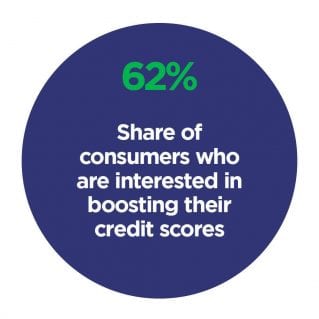摘要: In spite of alternative credit score initiatives by J.P. Morgan Chase, Wells Fargo and U.S. Bank, the traditional credit score system is not going away anytime soon, and consumers want help in understanding how to better manage and improve their scores.

▲圖片標題(來源: PYMNTS.com)
Consumers today believe a good credit score and an established credit history are essential to getting loans and credit cards. PYMNTS research found that almost two-thirds (62 percent) of consumers want to improve their credit scores but do not know how to go about doing so. This even includes consumers who have above-average credit scores. For instance, those with above-average credit scores are unsure whether having one line of credit or multiple lines of credit is better for their scores, or they are unsure of how spending close to their credit card limits affects their scores.
The Credit Score Literacy And Building Credit Report, a collaboration between PYMNTS and Elan (a division of U.S. Bank), explores consumers’ perceptions and plans around improving their credit scores. We surveyed a census-balanced sample of 2,053 consumers and found that they have interest in and ascribe value to credit card issuers that provide tools that can help both monitor and improve their credit scores.
The survey found that consumers have false confidence in the level of their credit scores. More than two-thirds think their scores are above average — nearly twice than the actual proportion. Seventy percent of surveyed consumers think their credit scores are “above average,” but only 45 percent of them have scores over 751, the above-average mark based on national credit reporting data. At the same time, only 8 percent of consumers believe their credit scores are “below average,” even though 21 percent have scores below 600, the actual range for below-average scores.
The perception gap gets smaller for consumers with average credit scores, or those between 600 and 700, as 19 percent of consumers think they have average credit, and in reality 29 percent actually do. Generation Z and paycheck-to-paycheck consumers have the greatest gap between perception and actual score, at 33 percentage points each between the share of them stating to have an above average credit score and those who actually do so. These discrepancies point to a knowledge gap and a need for better credit education.
In terms of credit card ownership, consumers have two credit cards on average, with baby boomers and seniors and high-income consumers having more, with 2.3 and 2.5 cards each. Generation Z averages only one. Only 24 percent of consumers do not have any credit cards issued.
Access to credit score tools influences consumers’ choice of credit cards. Thirty-seven percent of consumers would be at least “somewhat” likely to switch to cards that offer credit score improvement tools, and 18 percent would be “very” or “extremely” likely to do so. More than half (57 percent) of consumers would consider tools to monitor or improve their credit scores to be “very” or “extremely” important when choosing among credit cards. Only interest rates (66 percent) and rewards (77 percent) are cited more often.
轉貼自: PYMNTS.com
若喜歡本文,請關注我們的臉書 Please Like our Facebook Page: Big Data In Finance


留下你的回應
以訪客張貼回應